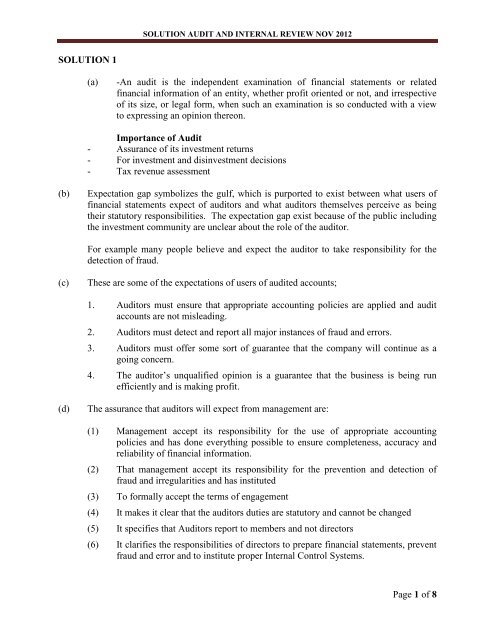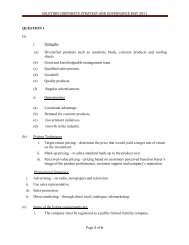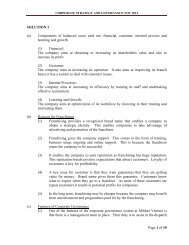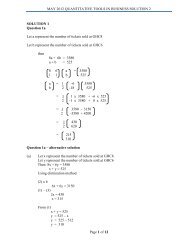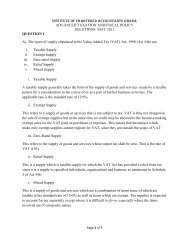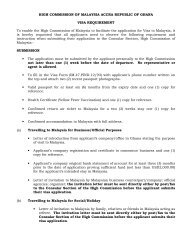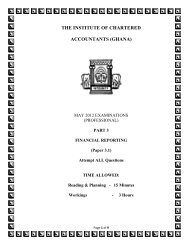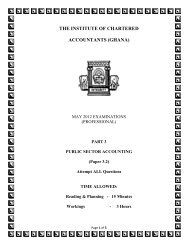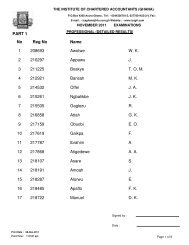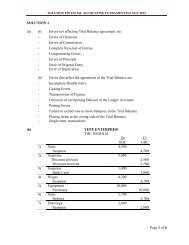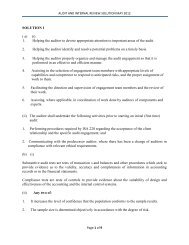SOLUTION AUDIT AND INTERNAL REVIEW NOV 2012
SOLUTION AUDIT AND INTERNAL REVIEW NOV 2012
SOLUTION AUDIT AND INTERNAL REVIEW NOV 2012
You also want an ePaper? Increase the reach of your titles
YUMPU automatically turns print PDFs into web optimized ePapers that Google loves.
<strong>SOLUTION</strong> <strong>AUDIT</strong> <strong>AND</strong> <strong>INTERNAL</strong> <strong>REVIEW</strong> <strong>NOV</strong> <strong>2012</strong><strong>SOLUTION</strong> 1(a)-An audit is the independent examination of financial statements or relatedfinancial information of an entity, whether profit oriented or not, and irrespectiveof its size, or legal form, when such an examination is so conducted with a viewto expressing an opinion thereon.Importance of Audit- Assurance of its investment returns- For investment and disinvestment decisions- Tax revenue assessment(b)Expectation gap symbolizes the gulf, which is purported to exist between what users offinancial statements expect of auditors and what auditors themselves perceive as beingtheir statutory responsibilities. The expectation gap exist because of the public includingthe investment community are unclear about the role of the auditor.For example many people believe and expect the auditor to take responsibility for thedetection of fraud.(c)These are some of the expectations of users of audited accounts;1. Auditors must ensure that appropriate accounting policies are applied and auditaccounts are not misleading.2. Auditors must detect and report all major instances of fraud and errors.3. Auditors must offer some sort of guarantee that the company will continue as agoing concern.4. The auditor‟s unqualified opinion is a guarantee that the business is being runefficiently and is making profit.(d)The assurance that auditors will expect from management are:(1) Management accept its responsibility for the use of appropriate accountingpolicies and has done everything possible to ensure completeness, accuracy andreliability of financial information.(2) That management accept its responsibility for the prevention and detection offraud and irregularities and has instituted(3) To formally accept the terms of engagement(4) It makes it clear that the auditors duties are statutory and cannot be changed(5) It specifies that Auditors report to members and not directors(6) It clarifies the responsibilities of directors to prepare financial statements, preventfraud and error and to institute proper Internal Control Systems.Page 1 of 8
<strong>SOLUTION</strong> <strong>AUDIT</strong> <strong>AND</strong> <strong>INTERNAL</strong> <strong>REVIEW</strong> <strong>NOV</strong> <strong>2012</strong><strong>SOLUTION</strong> 2(a)(i) On-line systems are those systems where input and output devices are directlylinked to and controlled by the central processing unit such that data cancontinuously and immediately be fed into the computer or extracted from it.Usually, files can be accessed by enquires such that data can be displayed on avisual display unit (VDU) or printed out at any time. On-line systems contrastwith batch systems where data is fed in and output taken at particular time only.Real-time systems are those systems where on line input and output facilities existbut where in addition processing of the input occurs immediately.A good example might be in banking. An on line system would enabletransactions (e.g. deposits or withdrawals) to be input as they occur and for files(e.g. of account balances) to be interrogated at will. However, if processing of theinput (e.g. Updating of customer accounts) does not occur instantly then enquirymay not elicit the balance updated for all transactions. If, however, a real timesystem was employed so that any input caused the files to be immediately updatedthen any enquiry would reveal the balance updated for all transactions. Thebenefit of this would be that decisions (e.g. to refuse to honour a cheque) could bemade with the benefit of knowledge of the completely up-to-date position.(ii)The major problem of such systems lies in the loss of audit trail. When files areupdated, obsolete information is usually deleted and the auditor is not able to tracethrough transactions and files after relatively short intervals of time.Further problems that can occur include:1. Absence of some documents. An object of on line input is to do away with paper.2. Authorisations are frequently program based (e.g. credit control) and cannot beinspected later.3. Output is often on to VDU‟s and hard copy is not available to the auditor.(iii)In one way, the auditor is unlikely to find the problems, in that they occur also tothe client who also must have control over his system. Audit trails are often builtin for internal audit and management supervision purposes.However, where the problems do occur then an auditor can:1. Persuade his client to implement an audit trail, for example by frequent print outsof transaction and master file data.2. Gain closer acquaintance with the client‟s system and programs so that the auditorcan gain evidence of the effectiveness of program based controls.3. Make detailed examinations of organisational controls particularly of the programand systems development controls. By this means the auditor can gain assuranceon the effectiveness and reliability of systems and programs.Page 2 of 8
<strong>SOLUTION</strong> <strong>AUDIT</strong> <strong>AND</strong> <strong>INTERNAL</strong> <strong>REVIEW</strong> <strong>NOV</strong> <strong>2012</strong>(b) (i) Teaming and ladingThis is also known as “covering over fraud” is a method used to substitute later cashcollected for earlier ones misappropriated.Receipts from debtors may be “switched” between ledgers. For example, a chequefrom a debtor – AA might be substituted for the same amount of cash received from adifferent person.Control Measures1) Recording the amount and nature of all receipts (cash, cheques, postal orders, etc).2) Listing all cheques banked by date and amount.3) Identifying the pay-in-slip by date, amount and number in the cash book.4) Cross-referencing individual debtors/receivables ledgers to the cashbook.5) Limiting cash balances held by cashiers.6) Operating a system of internal checks e.g. daily banking of cash, regularunannounced checks on the cashier.<strong>SOLUTION</strong> 3Ethical requirements are:1. IntegrityAn accountant should be straight forward, honest and sincere in his approach to hisprofessional work.2. ObjectivityAn accountant should be fair and must not allow prejudice or bias to override hisobjectivity.3. IndependenceWhen in public practice an accountant should both be and appear to be free of anyinterest which might be regarded, whatever its actual effect as being incompatible withintegrity and objectivity.4. ConfidentialityAn accountant should respect the confidentiality of information acquired in the course ofhis work and should not disclose any such information to a third party without specificauthority or unless there is a legal or professional duty to disclose. He should also notuse this information to his advantage or for the advantage of third party.Page 3 of 8
<strong>SOLUTION</strong> <strong>AUDIT</strong> <strong>AND</strong> <strong>INTERNAL</strong> <strong>REVIEW</strong> <strong>NOV</strong> <strong>2012</strong>5. Technical Standard/Professional Duty of CareAn accountant has a duty to carry out his work with care and skills and in conformitywith the professional and technical standards promulgated by his professional body andin the legislation of his country and instructions of the client insofar as they are notincompatible with the requirements of integrity, objectivity and independence.In the light of these, the accountant must be conversant with GNSA, GAS, IFRS andCompany‟s Code, 1963 Act 179.6. Professional competenceAn accountant who accepts a professional engagement implies that he has the necessarycompetence to carry out the work and will apply his knowledge, skill and experience withreasonable care and diligence. He should therefore refrain from undertaking orcontinuing any assignments which he is not competent to carry out unless he obtains suchadvice and assistance as will enable him carry out his task satisfactorily.7. Ethical BehaviourAn accountant should conduct himself in a manner consistent with the good reputation ofthe profession and refrain from any conduct which might bring discredit to theprofession. The obligation to refrain from any conduct which might bring discredit to theprofession requires the professional body of the country to consider, when developingethical requirements, the responsibilities of an accountant to clients, third parties and thegeneral public. Some specific matters that require considerations are:(a)(b)(c)(d)The financial liability of an accountant for the acts and defaultsAdvertising, publicity and solicitation by accountants in public practiceReceipts and payment of commission by an accountantThe basis on which fees are charged by an accountant in public practice.(b)Need for engagement letter1. Under statutory audit: The scope of the audit and the auditor‟s responsibilities aswell as the responsibilities of the management is defined by law. But even understatutory audit the auditor may agree to render other services to the client. Thescope of these services must be refined in defined in writing.2. Under non- statutory audit: The scope of the audit as well as other services to beperformed by the auditors must be the subject of an agreement between the clientand the auditor. This agreement must be set out in the engagement letter.3. Furthermore, the Company‟s Code 1963 Act 179 (Sub-Section 1 of Section 143)states that no person can be appointed as an auditor of a company unless he hasfirst consented in writing to be appointed.Page 4 of 8
<strong>SOLUTION</strong> <strong>AUDIT</strong> <strong>AND</strong> <strong>INTERNAL</strong> <strong>REVIEW</strong> <strong>NOV</strong> <strong>2012</strong>4. The professional accountancy bodies also require that their members should sendEngagement Letters to clients before the commencement of any professionalwork.5. The auditor need to send an engagement letter to all new clients and to existingclient when a substantial change has occurred in the scope of the audit on otherservices to be performed or in the change of the management of the client.6. It is in the interest of both client and the auditor that the auditor send anengagement letter, to help in avoiding misunderstanding with respect to theengagement.(c)Internal Controls relating to instituted to achieve the following:1. Transactions are executed in accordance with management‟s general or specificauthorisation.2. All transactions are promptly recorded in the correct amount, in the appropriateaccounts and in the accounting period in which it relates so as to permitpreparation of financial information within a framework of recognised accountingpolicies and to maintain accountability of assets.3. The records of assets are compared with the physical assets at reasonable intervalsand appropriate action taken on any differences.<strong>SOLUTION</strong> 4(a) Factors affecting audit risk:(1) Probability of an error occurring(2) Potential size (Materiality) of an event(3) Internal control strengths and degree of compliance(4) Size of departments(5) Usage of cash or other negotiable instruments(6) Portability, attractiveness, unit value of stocks(7) Size and hence possibility of collusion in department‟s staff(8) Previous experience(9) Experience on other audits(10) Discussion with staff especially internal audit(11) Assessment of managerial competence(12) Ratio analysis (especially gross profit)(13) High stock level departmentPage 5 of 8
<strong>SOLUTION</strong> <strong>AUDIT</strong> <strong>AND</strong> <strong>INTERNAL</strong> <strong>REVIEW</strong> <strong>NOV</strong> <strong>2012</strong>(14) Relation of credit notes to sales(15) Staff turnover especially of managers(16) Budget variances(b)Five Responsibilities/Functions of Audit Committee(i)(ii)(iii)(iv)(v)(vi)(vii)To review (formally and regularly) the financial results shown by bothmanagement accounts and those presented to shareholders.To make recommendations for the improvement of management controlTo ensure that there are adequate procedures for reviewing „rights‟ circulars,interim statements, forecasts and other financial information before distribution toshareholders.To assist external auditors in obtaining all the information they need and inresolving difficulties experienced by them in pursing their independentexaminationTo deal with any material reservations of the auditors regarding the company‟smanagement, its records and its final accounts, including the manner in whichsignificant items are presented.To facilitate a satisfactory working relationship between the management andauditors, and between the internal and external audit functions.To be responsible for the appointment of auditors as well as fixing theirremuneration.(viii) To be available for consultation with the auditors at all times, if necessary,without the presence of management to discuss regularly and review theprocedures employed by the auditors.(ix)To be concerned with all matters relating to the disclosure by the accounts of atrue and fair view for the benefit of all users.(c) (i) An officer of the company or of any associated company;(ii)(iii)(iv)(v)(vi)A person who is a partner or in the employment of an officer of the company, orof any associated company; save that partnership with a person acting as aSecretary or Registration Officer of the company or any associated company shallnot constitute a disqualification;An infant;A person found by a competent court to be of unsound mind;A body corporate except that members of an incorporated partnership may beappointed;Anyone in respect of whom an order has been made under section 186 of theCode so long as such order remains in force unless leave to act as auditor of thecompany concerned has been granted by the court in accordance with the saidsection;Page 6 of 8
<strong>SOLUTION</strong> <strong>AUDIT</strong> <strong>AND</strong> <strong>INTERNAL</strong> <strong>REVIEW</strong> <strong>NOV</strong> <strong>2012</strong>(vii)An un-discharged bankrupt, unless he shall have been granted leave to act as anauditor of the company concerned by the court which adjudged him bankrupt.<strong>SOLUTION</strong> 5(a) (i) Planning the AuditThe following is a description of desirable planning procedures for the audit ofLAMPS LTD.(1) Read the previous years audit files paying particular attention to points raised anddifficulties encountered. Apart from giving the new auditor an opportunity ofbecoming familiar with the audit, this will enable him to form a view on theextent to which the current audit may be affected by items recorded in theprevious year‟s audit file.(2) Assess the effects of changes in legislation (Companies Code) or in accountingpractices.(3) Review interim accounts, management accounts statements issued in connectionwith stock exchange requirements.(4) Consult with senior staff of the clientThe object of the two procedures above, it to enable the auditor to appraisehimself of the current trading circumstances and significant changes to thebusiness, its personnel, its locations and accounting procedures.(5) List the timing requirements of the audit. This will involve considerations ofwork division between interim, year-end and final audits. It will also benecessary to consider the clients requirements and abilities in connection with thepreparation and printing of accounting statements and the dates of meetings.(6) Consider the degree of co-operation that can be experienced with internal audit.(7) Determine he need for the preparation of audit working schedules and the degreeto which they can be supplied by the client.(8) Assess the availability of staff of the different levels of experience and ability andendeavour to match the available staff with the particular needs of this audit.(9) Brief the staff on the particular problems of this audit. They should be madeaware of the existence of related parties and the need for investigation of allmatters where they are put upon enquiry.(10) Prepare a memorandum setting out the approach to be adapted to the audit. Thismemorandum should state in outline:(a)(b)(c)Each item on the financial statement and how, when and by whom, it willbe verified.The timing requirements that need be met.Staff usage with a time budget for each section of the audit.Page 7 of 8
<strong>SOLUTION</strong> <strong>AUDIT</strong> <strong>AND</strong> <strong>INTERNAL</strong> <strong>REVIEW</strong> <strong>NOV</strong> <strong>2012</strong>(b)(ii) Controlling the AuditThe following procedures could be used to control the audit:(1) Allocation of work to staff who are capable of performing the work given to themsatisfactorily. This means staff of adequate training, experience, age and ability.(2) Full briefing of staff as to the work expected from them, the problem they mayexpect to meet and the matters to which they should direct their particularattention.(3) Precise instruction to audit staff to bring to the attention of more senior staff anyproblems encountered and any “put upon enquiry” situations.(4) Completion of working papers in such a meticulous and complete manner that allaudit actions are recorded.(5) Reviews of the work performed and the working papers completed by each auditassistant, by more senior staff. Acknowledgement of such review should beincorporated into the working papers.(6) Use audit completion check lists with sections for completion by each level ofstaff including the final review by the partner in charge,. This should ensure thatall work has been completed and that opinions have been formed on each item inthe accounts.(7) Facilities for consultation with other partners and personnel with specialistknowledge when second opinions or specialist knowledge are required.(8) Overall quality control by means of a „hot‟ review or other techniques ofinvestigation or monitoring of audits by senior people not connected with theaudit.Source of Knowledge(i) Previous experience with the entity and of its industry.(ii)(iii)(iv)(v)(vi)(vii)Discussion with people within the entity (eg. junior and senior managers).Discussion with internal audit personnel and review of internal audit reports.Discussion with auditors (including predecessor auditors) and with legal and otheradvisors who have provided services for the entity or within the industry.Discussion with knowledgeable people outside the entity, (for example industryeconomists, industry regulators, customers, suppliers, competitors).Publications related to the industry (from government, banks and securitiesdealers, financial newspapers) etc.Legislations and regulations that significantly affect the entity.(viii) Visits to the entity‟s premises and plant facilities.(ix)(x)Documents produced by the entity (for example minutes of meetings, materialssent to shareholders, promotional literature, prior-years annual and financialreports, budgets, management policies, accounts, job descriptions, marketing andsales plans.Industry-specific guidance.Page 8 of 8


